This interview with Saranac Lake native Natalie Leduc took place on March 15, 2010 in Lynda Peer's eighth grade English class at the Petrova Middle School. Historic Saranac Lake's Executive Director, Amy Canania, arranged and participated in the interview.
| Natalie Leduc: | Kiwassa, Lake Kiwassa Road, over on the other side of the lake, you know where I mean, on the other side of the lake? Anyway, I grew up on that street, and we didn’t have buses, we walked to school, which was not a big deal. But, going by all of the houses, were people in the houses, used to wait for school to get out, and then they would get to the doors and windows and wave and wave and a whole bunch of us kids would always stop and wave… and if they could open the window they’d open it and talk to us and ask us what we did in school today. |
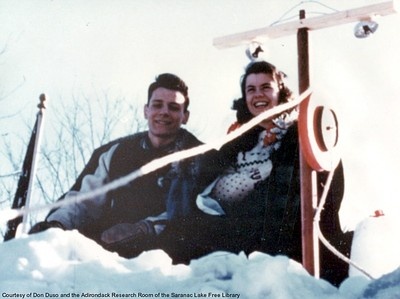 King and Queen Tom Fina and Natalie Bombard, 1951 King and Queen Tom Fina and Natalie Bombard, 1951 |
| Can you imagine being fourteen or fifteen or sixteen, having tuberculosis and being locked into a house and nobody comes near you? So, yeah, it’s pretty yuck. Some of them had very wealthy parents, and they built houses for them, and there are a number of the them here in Saranac Lake, well I don’t know if you even know the names, but the guy that owned Arrow Shirt [Walter Cluett], it was a man’s shirt company, he built a house for his daughter. A lot of people did that so they could be close to their daughter or their son and know that they were OK, know they were living in an OK place. So these people were locked up, just plain locked up, so it was fun for them to see us go by. | ||
| You know, there were a couple of really strange rules, you will see as strange. You cannot, (did you ever heard of the word expectorate? It means spit.) you could not expectorate on the street because then those germs were lying there and would dry up and be apt to blow away. So they had little cups, they called sputum cups. And they were just…it was a little cup with a little cover. They carried in their pocket and then when they had to expectorate they pulled it out, expectorated, and then put the cover back on. That was a fifty dollar fine if you were caught spitting on the street. In fact, I’ll bet you a nickel that rule, that law is still on the books. I bet nobody has looked at it, or if they did they probably thought, what does that mean? But that is what it meant. | ||
| Now were we talking about Martha Reben? Martha Reben was a lovely, beautiful girl. She had high color in her cheeks and very rosy cheekbones. She had dark eyes and dark hair. She just sparkled, she was so pretty, and she was so sick, so sick, with TB when she came here. Now it was an unusual cure to take someone in the woods, as she did. But you know, we’re Aidrondackers, I’m sure every one of you believe as I believe, this could be the cure. If you eat properly and get a lot of rest, which none of us ever do, that could be a great way to cure. Fish a little in the morning, cook your fish for lunch. She lived a very quiet, very quiet life. She was very happy here. She wrote three wonderful books, just wonderful, very easy to read books. Do you have them at school, do you think? |
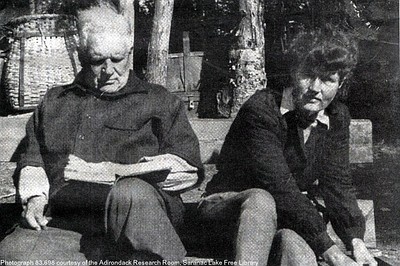 Martha Reben and Fred Rice. Adirondack Daily Enterprise Martha Reben and Fred Rice. Adirondack Daily Enterprise |
|
| Lynda Peer: | No, I don’t think so. We are going to be looking at bits of it, we'll look at some of them. | |
| Natalie Leduc: | OK. Well, at any time I would love to come and talk to you again.... | |
| Natalie Leduc: | It was a very, very, very, very sad time. We were young, we were your age. We didn’t know that. We didn’t understand what it would mean to be cooped up. And, most of the people who were here had much. They weren’t struggling for a living. Most of them had enough money to send them up here and pay the expense of living here. And those who didn’t, it was kind of tough going for them. There were a lot of houses that took them in, cure cottages. Have you heard those words? That whole street, that Riverside Drive (was it?), yeah, Lake Kiwassa (I’m losing it)1. | |
| Lake Kiwassa Drive had loads and loads of people who were wealthy living on that street. And when you go up that street again, look at the houses. Every one of them has a porch on the front. All those big houses have porches. So when they had their rest period, like from 2 to 4, they would be out resting on their porch. And of course, that’s the time we got out of school. So, they’d all be out and would hurry to wave to us and hope one of us would stop and talk to them. They did a lot of smoking…can you believe that, with a disease of the lungs? They did a lot of smoking, which I find impossible to believe. | ||
| Question: | These are the patients that did the smoking? |
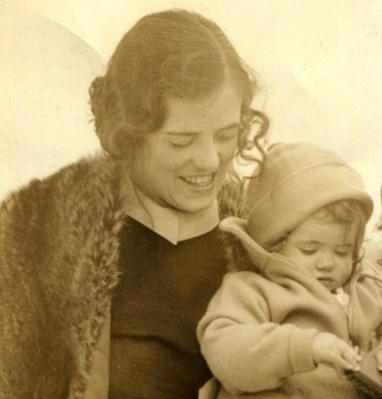 Natalie's mother, Charlotte Bombard, and Natalie Natalie's mother, Charlotte Bombard, and Natalie |
| Natalie Leduc: | The patients. A lot of smoking. I can’t believe when your lungs ache, and you would put smoke in your lungs, but they did. But the doctors smoked too. Everybody smoked in those days. | |
| Question: | Natalie, now can you tell us how you and your family got to know Martha Reben? | |
| Natalie Leduc: | Well, my mother was a very peppy, energetic young woman. She was just as pretty as could be. In fact, I have a picture to show you. And, she met a lot of these young, particularly young, women, because she was their age. And so made friends with this gal, but the other weird part of the story (are you ready for this?)… My grandmother had a sister named Perdita, very pretty name when you think about it. And Perdita was married to Fred Rice. | |
| Question: | Fred Rice was the guy who took Martha on her first journey down to Weller Pond. That was his camp. | |
| Natalie Leduc: | Yes. | |
| Question: | So, you knew Fred Rice too? | |
| Natalie Leduc: | Yes. | |
| Question: | What do you remember about Fred Rice? | |
| Natalie Leduc: | Well, he was heavy. Had a wonderful chuckle….he had a belly, it would go up and down. He was very nice. He was jovial. He looked like a wonderful Santa Claus with no beard. | |
| Question: | How old were you when you met Martha? | |
| Natalie Leduc: | Oh, I was in early teens…late pre-teens. I used to go to camp with them a lot (I like your shoes). She was never married and his children were all grown up. And they took me up and I was well-behaved. They used to take me fishing, and at night we slept in a tent right at the edge, right at the edge of the pond. They use to put nets, great big nets they had on top of the roof of this little tent and they pulled it down at night and you got tucked in. All of the corners all the way around got tucked in so the mosquitoes wouldn’t eat you alive. But it was great. | |
| I remember it so well, lying there listening to fish rise. You know how they rise and ssssshht? Oh it was wonderful. It was wonderful to hear that. And she had a raccoon, that was a very friendly raccoon. So that was fun. And that was wonderful, so I used to love to go and see him. And she had some ducks. Mr. Dooley was one of them, and he was a nice duck. He really was OK. He bit me a couple of times but, you know, what are you gonna do? | ||
| She loved wildlife, just loved wildlife, and so she harbored everything that came near her. She just loved it. She had come from the city. She had never been around woods before, ever. All she knew was concrete. And so she really, really believed in the lifestyle, and that’s what she started to write….was because she was happy, she was so ill, so near death. | ||
| Question: | When you were with her was she up and walking, and really healthy or fairly looking healthy then, or was she still ill? |
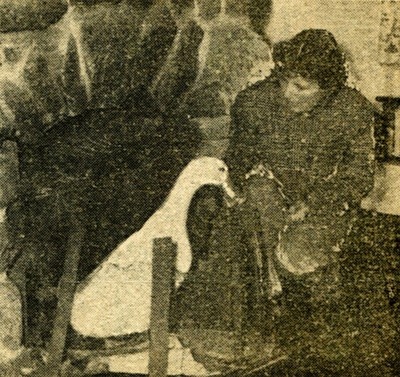 Reben and her duck, Mr. Dooley, April 4, 1952. Adirondack Daily Enterprise, Reben and her duck, Mr. Dooley, April 4, 1952. Adirondack Daily Enterprise, |
| Natalie Leduc: | Yeah. She was very healthy looking until she was close to the end of her life and then she became very pale. Yeah, she was a pretty, pretty girl. | |
| Question: | What made her, do you think, decide to go off into the woods instead of staying here in town? | |
| Natalie Leduc: | Well, she answered an ad in the New York paper. And her father had, he wasn’t really rich, but he wasn’t really poor either. So he could afford to send her up here and try it. And, she was a daring young woman. I mean she was desperate, she was dying. And she knew that. So she was willing to take a little bit of a risk. So she came up, she liked Fred. He was quite a bit older. He was a very nice old man. And so she answered the ad. | |
| Question: | Now, her books were published during her lifetime. Was she kinda famous in the village? | |
| Natalie Leduc: | Yeah, well… | |
| Question: | Did people say, "ooh, there’s Martha Reben?" | |
| Natalie Leduc: | It wasn’t like that. There were so many famous people in this town that I could tell you the number of things that happened, but you wouldn’t know any of the actors, but well, ever hear of the lady, Veronica Lake? No, well she became a beautiful movie star…a very well known movie star. She was my babysitter. It was that kind of a place. | |
| We lived right next door to a house where a whole lot of…we called them "tubers" (tuberculosis), so we nicknamed them. So we lived next door to a bunch of tubers always. There were (see I am so old you won’t know the names),Yankee Doodle Dandy? You know where Will Rogers is, right across from… | ||
| Lynda Peer: | Grand Union. | |
| Natalie Leduc: | Yeah. They used to do a lot of shows there and anyone who was at Will Rogers used to live there free because they had been in the movie industry. And that’s why they supported Will Rogers, and to this day I understand they still take collections in different places for Will Rogers. | |
| And all during those years they always took a collection. The money went for Will Rogers to support the building for these people who were so kind to these people who were so sick. But you would walk down the street and you saw all kinds of people you saw in the movies. | ||
| Question: | Did you ever see Einstein? | |
| Natalie Leduc: | I don’t know if I ever did because we were on the lake a lot. But you know, we didn’t have television of course. So there were not a lot of ways to be introduced to him, or to know much about him. If your teacher was a history buff you learned a lot. If she wasn’t into history you didn’t learn an awful lot about history. | |
| But there were a lot of famous people here. It’s the way it was and you didn’t think anything of it. James Cagney, did you ever hear that name? | ||
| Remember some of those patriotic movies? Well they are on the old shows, the old movies now. He was here for quite a while. A number of people came here and just gave performances for people at Will Rogers. It is still very much as it was. There is a stage, a platform where these people performed, and it’s still there now in that same room. So it is kind of fun to go in and sit where I used to sit with my mother and watch some of these shows. It was quite a time. It was a great time. | ||
| We had very strict rules. We had to be in the house at 9:30, no kidding around. They had a curfew and the cops were out. If you were on the streets you got a ride home. We used to live in a house, I always lived here. There used to be a place called the Curling Club over where Madden’s Garage is now. Anybody know where that is? That used to be a skating rink. And at 9:30, I have a brother who’s just my age, and we would run like the devil across the lake, (oh God, think of it now) cross the lake, and the first one to get on the porch would hit it, hit the deck, so Dad would know you were in, 'cause you had to be in by 9:30. |
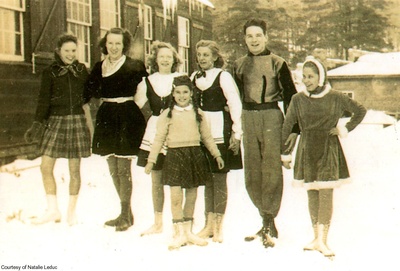 Skaters at the Curling Club, 1940. Bernadette Harrigan, Alice Walsh, unknown, Natalie Leduc, Phyllis Harton, John Walsh, Ruth Lamy. John Walsh was Sonja Henie's skating partner on professional tours. Skaters at the Curling Club, 1940. Bernadette Harrigan, Alice Walsh, unknown, Natalie Leduc, Phyllis Harton, John Walsh, Ruth Lamy. John Walsh was Sonja Henie's skating partner on professional tours. |
|
| There were a number of people who skated, a number of elder people who skated. A lot of the doctors skated. They had a lot of their training in Montreal, at McGill University, so they were introduced to winter sports while there in that area. So they knew how to skate, how to ski. One of the first doctors brought the first skis into Saranac Lake and he was a tuberculosis doctor. So they brought a lot to the village, they brought a lot to the village. And the village expected a lot from them. They were the board of education, they were the school board. They were all the boards for the important things in the village. They were board members. And they insisted upon an excellent education for the students, so I was one of the [inaudible] all the young people at that time. | ||
| Any questions you can think of? It’s a great big topic to cover in just a few minutes? | ||
| Question: | Were you and Martha the same age? | |
| Natalie Leduc: | No. No. She was a lot older, I mean she's a lot older. Probably about mid-twenties and I was probably 10, 11. But I really knew how sick she was. You know girls know those things. She was a gal who was very sick. | |
| Amy Catania: | Well, Natalie, thank you. I think it is time for the kids to start walking so they don’t miss the buses. We really enjoyed it. | |
| Natalie Leduc: | Well, thank you very much, and anytime. | |
| Amy Catania: | And they’re going to be doing some dramatic monologues about Martha Reben and some of the characters she knew, so hopefully they will get a chance to share some of their work with you. | |
| Natalie Leduc: | Oh, I would love to see it. I would love to see it. | |
Footnotes
1. Natalie's confusion is natural— the northernmost section of what used to be Riverside Drive was renamed Kiwassa Road in 2004.



